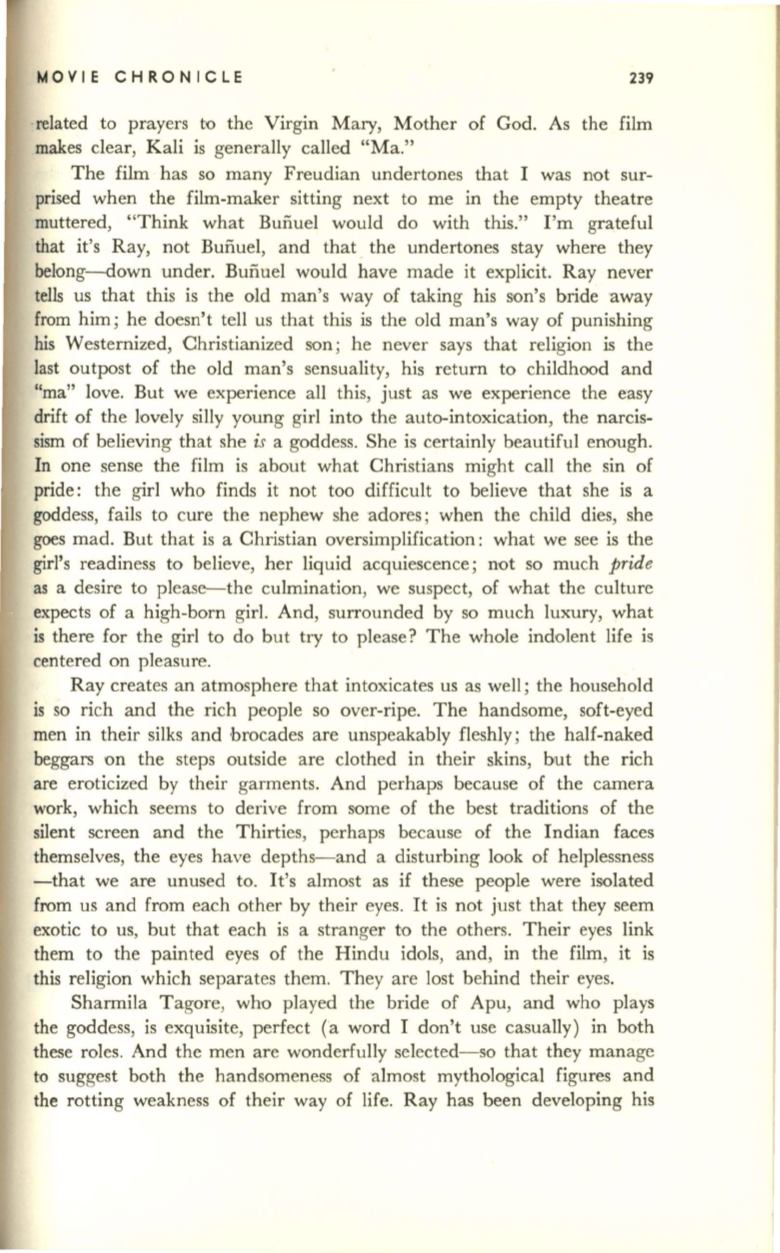
MOVIE CHRONICLE
239
.related to prayers
to
the Virgin Mary, Mother of God. As the film
makes clear, Kali is generally called "Ma."
The film has so many Freudian undertones that I was not sur–
prised when the film-maker sitting next to me in the empty theatre
muttered, "Think what Bunuel would do with this." I'm grateful
that it's Ray, not Bunuel, and that the undertones stay where they
belong-<lown under. Bunuel would have made it explicit. Ray never
tells us that this is the old man's way of taking his son's bride away
from him; he doesn't tell us that this is the old man's way of punishing
his Westernized, Christianized son ; he never says that religion is the
last outpost of the old man's sensuality, his return to childhood and
"rna" love. But we experience all this, just as we experience the easy
drift of the lovely silly young girl into the auto-intoxication, the narcis–
sism of believing that she
is
a goddess. She is certainly beautiful enough.
In one sense the film is about what Christians might call the sin of
pride: the girl who finds it not too difficult to believe that she is a
goddess, fails to cure the nephew she adores; when the child dies, she
goes mad. But that is a Christian oversimplification: what we see is the
girl's readiness to believe, her liquid acquiescence; not so much
pride
as a desire to please--the culmination, we suspect, of what the culture
expects of a high-born girl. And, surrounded by so much luxury, what
is there for the girl to do but try to please? The whole indolent life is
centered on pleasure.
Ray creates an atmosphere that intoxicates us as well; the household
is so rich and the rich people so over-ripe. The handsome, soft-eyed
men in their silks and brocades are unspeakably fleshly; the half-naked
beggars on the steps outside are clothed in their skins, but the rich
are eroticized by their garments. And perhaps because of the camera
work, which seems to derive from some of the best traditions of the
silent screen and the Thirties, perhaps because of the Indian faces
themselves, the eyes have depths-and a disturbing look of helplessness
-that we are unused to. It's almost as if these people were isolated
from us and from each other by their eyes. It is not just that they seem
exotic to us, but that each is a stranger to the others. Their eyes link
them to the painted eyes of the Hindu idols, and, in the film, it is
this religion which separates them. They are lost behind their eyes.
Sharmila Tagore, who played the bride of Apu, and who plays
the goddess, is exquisite, perfect (a word I don't use casually) in both
these roles. And the men are wonderfully selected-so that they manage
to suggest both the handsomeness of almost mythological figures and
the rotting weakness of their way of life. Ray has been developing his


